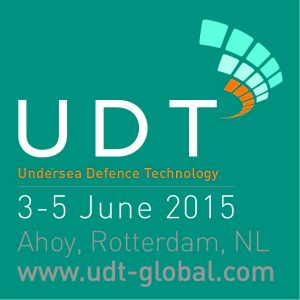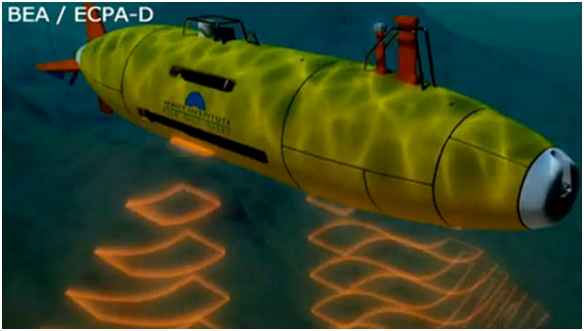 Over 1200 military personnel, industry leaders, researchers and academics attend Undersea Defence Technology (UDT), which annually provides a world-class platform to discuss technology developments, understand the latest requirements and present innovative solutions that can be exploited in the underwater domain. UDT 2015 will take place at the Ahoy Convention Centre in Rotterdam, Netherlands, from 3 – 5 June 2015.
Over 1200 military personnel, industry leaders, researchers and academics attend Undersea Defence Technology (UDT), which annually provides a world-class platform to discuss technology developments, understand the latest requirements and present innovative solutions that can be exploited in the underwater domain. UDT 2015 will take place at the Ahoy Convention Centre in Rotterdam, Netherlands, from 3 – 5 June 2015.
Rotterdam, a key maritime city and a crucial port for global trade and naval power projection, still serves as an important international calling: this was evident in late January, when warships from the People’s Liberation Army Navy paid a port call en route from the Gulf of Aden.
UDT 2015 developments
The Netherlands Industries for Defence & Security (NIDV) have become a key partner for the 2015 show. This is a significant endorsement for UDT as NIDV is a key player in the underwater defence community. A non profit organisation, NIDV represents the interests of Dutch defence and security industries, acting as a mediator between government, politicians, institutes and industry. Its responsibilities include working with Dutch and overseas companies on issues such as offset commitments.
Research and development remains a key pillar for UDT 2015 as it gets the international tech community together again. Ton Van Koersel, Senior Business Developer, Underwater Warfare at TNO Defence, Safety and Security will be the Conference Committee Chair. The UDT 2015 conference will address both the technological and doctrinal solutions to various issues currently in the underwater space. Ton has a profound understanding of the current uncertain strategic context and the need for cost effective, technology based, less manpower intensive solutions. He also recognises the growing need for countries to partner in order to counter major threats. In common with many other countries, the Netherlands cannot resource a large underwater programme but sees asymmetric advantage in investing in one that is made in cooperation and collaboration with others.
Conference themes reflect direction industry and tactics are moving
The themes of the UDT conference are in concert with the direction that undersea tactics and the undersea industry are moving. ‘Underwater Capability for an Uncertain Future’ is the overall theme of the UDT 2015 conference. The conference is renowned for its responsiveness to significant developments in the subsea environment, not least in countering the evolving threat portfolio. This fact is reflected in the 2015 agenda which encompasses submarine warfare, anti-submarine warfare, mine warfare, hydrography/environmental assessment and maritime security.
Prominence is given to autonomous vehicles in a conference stream that includes mine counter measures; multiple vehicle operations; countering UAVs; and operational, legal and ethical issues. Alongside established themes such as operating in the hostile underwater environment, sensor technology and platform design. UDT’s platform design content is widely recognised as an authoritative source of learning and this year’s agenda will look at energy, power and propulsion, signature management, performance modelling and safety.
Autonomous growth
Subsea developments have steadily increased in recent years. The principle driver for subsea growth is an increasing trend towards deepwater oil and gas and the emerging deep sea mining developments brought about by continued demand for oil, and the need to replace maturing shallow water basins as well as, the increasing demand for precious metals and marine renewable energy. Unmanned system activity in this market is growing fast. The importance of unmanned systems is reflected in the UDT exhibitor base, French company ECA are one to look out for. ECA design and manufacture a wide range of unmanned systems. Their subsea applications range from survey to inspections to mining to tracking of telecommunications and power cables. Among the solutions proposed by ECA Group, are autonomous and specifically designed systems that carry out a variety of inspection tasks from ultra-deep offshore oilfields to inspection of pipelines, risers and mooring lines.
Comment – Technology playing important part assisting in underwater searches
Note: Technology played an important part in trying to locate debris from the Malaysia Airlines Flight 370 that went missing in March 2014. While the underwater drone did not locate the plane, it showcased the potential of a growing technology that some experts believe could one day take a greater role in undersea warfare, recovery missions, logistic operations and environmental study. Autonomous technology will be at the forefront of UDT 2015.

Technology played important part in trying to locate debris from the Malaysia Airlines Flight 370 that went missing in March, and will be essential in trying to recover any wreckage from its likely resting place in the southern Indian Ocean. The search for the Boeing 777 aircraft – which carried 239 people onboard – has been unsuccessful, with few clues emerging about the fate of the passengers and crew. A myriad of technologies have been employed to locate the lost plane, but it is perhaps a Bluefin Robotics’ unmanned underwater vehicle that has made some of the biggest waves. It is of note that Seebyte, a confirmed exhibitor at UDT, are part of Bluefin.
While the underwater drone did not locate the plane, it showcased the potential of a growing technology that some experts believe could one day take a greater role in undersea warfare, recovery missions, logistic operations and environmental study. While scouring the bottom of the ocean, the Bluefin-21 dove to crushing depths of 5, 000 meters. The AUV measures a little more than 16 feet in length and 21 inches in diameter. It weighs 1, 650 pounds and can reach maximum speeds of 4.5 knots, depending on attached payloads. It can operate for 25 straight hours.
The Bluefin-21 was deployed within days of the plane’s disappearance to collect critical side-scan sonar data along the bottom of the ocean floor. In total, it was used for 25 missions over 21 operational days. The vehicle clocked in 370 hours of search time while covering 250 square miles. Following the search, the Bluefin-21 received an enormous amount of international attention and overall, the domestic and international AUV market is a burgeoning one. While unmanned underwater vehicle technology is advancing rapidly, it is not maturing as quickly as UAVs. Part of the reason is because AUV engineers face a technological barrier that aerial drone developers do not, namely that AUVs have to be almost completely autonomous because oceans are opaque to radio signals.
Acoustic signals are one solution, but because they travel at the speed of sound, they can be slower than using radio signals. The US Office of Naval research (ONR) is working on projects that tackle the autonomy issue, including the large displacement unmanned underwater vehicle (LDAUV). It is designed to survive and operate in littoral environments for 60 days or more. It should also be able to transit the open ocean and conduct over-the-horizon missions in littoral waters.
It could potentially complete missions such as mine countermeasures, deploying sensors or transporting items from different parts of the ocean to another. A prototype is slated for completion by 2017. Key areas in the development of the LDAUV include greater autonomy and the creation of efficient fuel cells that will facilitate long-term submersion. Better reliability is another goal of the program. On a submarine or a ship, a sailor can fix a small problem – such as a broken pump – relatively quickly.
One of the biggest focus areas of unmanned underwater vehicle development is decreasing risk for sailors deployed in mine-heavy areas. The Knifefish program, led by General Dynamics, is one of the leading AUV technologies is this area. The underwater drone will be used for mine countermeasures aboard the littoral combat ship. With the ability to reliably detect and identify volume, bottom and buried mines in high-clutter environments, Knifefish acts as an off-board sensor while the host ship stays safely outside the minefield boundaries; and in addition to enhancing intelligence reporting and situational awareness for commanders and the fleet, Knifefish also significantly reduces risk to Navy personnel.
The AUV completed its critical design review and risk reduction program last year. It was slated for in-water testing trials this past summer. While mine countermeasures are one of the most high profiles uses of AUV technology, the potential applications are limitless. Uses include environmental research and monitoring marine life. They could even one day be used for cargo transport if travel on the sea’s surface is treacherous.
For the most part, the military has been the biggest investors and buyers of AUVs. In the future, more commercial and civil entities will likely begin to use underwater drones to do dull, dangerous, difficult and dirty tasks. The commercial sector will further embrace AUVs as prices drop, in turn creating more innovation. At the Defense Advanced Research Projects Agency, scientists and engineers are working on a number of AUV-related projects intended to increase their speed and utility.
DARPA is allocating nearly $14 million in fiscal year 2015 for the Blue Wolf AUV program, according to a Department of Defense fiscal year 2015 budget estimate document. The program – which is under the agency’s tactical technology office – aims to develop ways to reduce drag on the AUV. Another high profile DARPA project is the Hydra program. Scientists working on Hydra are developing an underwater drone that can lay idle on the ocean floor and deploy various payloads to the surface when commanded.
The system will include communication platforms, command-and-control packages, energy storage units and various payloads, the document said. Payloads could include intelligence, surveillance and reconnaissance platforms and mine countermeasures. DARPA allocated nearly $30 million for the program in fiscal year 2015, according to the document. That is in addition to the nearly $15 million it received in funding in fiscal year 2014. The agency plans to create concept designs and work on the development of prototypes for the payloads and enclosures over the upcoming fiscal year.
Equipment from UDT exhibitors such Kongsberg Defence Systems and Atlas Elektronic Gmbh have played an important role in the search for MH370. According to the Royal Malaysian Navy’s National Hydrographic Centre, the survey vessel Mutiara’s suite of sensors included an Atlas Elektronik Hydrosweep MD-2 multibeam sonar, and an Atlas Elektronik Deso 25 single-beam echo sounder. Another survey vessel The Equator, had on board a Kongsberg 302 multibeam system with a range of 7, 000m to 10, 000m. Moreover, in the first phase of the search for the vanished MH370, three autonomous underwater vehicles (AUVs) from Kongsberg Maritime were used. UDT exhibitor ECA also has range of solutions for underwater searches such as the H800 Observation Class ROV and light duty work system designed for inspecting wrecks.
EXHIBITOR NEWS
For more info on UDT visit www.udt-global.com or contact UDT Press Office, John Hony/Nick Johnstone+44 (0)20 8899 6734 john.hony@cmsstrategic.com
About UDT
UDT 2015 will be the 28th edition. UDT is the only dedicated undersea defence technology conference and exhibition, bringing together naval procurement specialists, defence scientists and key technology providers for discussion, networking and the examination of new technology. The event, which is staged in Europe and Asia, covers the entire spectrum of undersea defence and security technology and the emphasis is very much on preparing for the future by identifying today the factors that are shaping the future of undersea security.
About Clarion Events Limited
Clarion Events is the largest independent and one of the top three events organising companies in the United Kingdom, running exhibitions, conferences and seated events across Britain, Europe, the Americas, Middle East and Asia. Clarion’s business-to-business and business-to-consumer events serve 15 different market sectors including: defence & security, leisure, entertainment, finance, retail, gaming, fine art and energy. To learn more, please visit www.clarionevents.com





